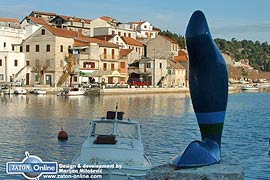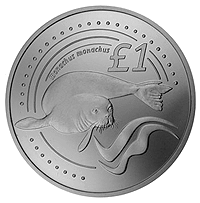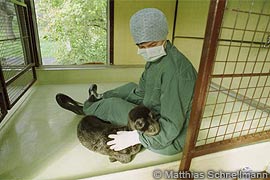

 |
||
 |
||
Vol. 9 (1): June 2006 |
||
Croatia / Cyprus / Greece / Madeira / Mauritania & Western Sahara / Spain / Turkey
Croatia
|
 |
|
|
Commemorating the Games. Courtesy: Zaton Online. |
Under a perhaps suitably titled section, “Curiosities”, the promotional website for the coastal resort town of Zaton, near Sibenik, announces that a “big statue” of the Mediterranean monk seal (Monachus albiventer – sic) now graces its shoreline.
The sculpture was created in 1979, when the species was actually chosen as a mascot of the Mediterranean Games, in which Zaton hosted the rowing and kayak events. The honour, unfortunately, did little to stem the monk seal’s precipitous decline in Croatia, where it is currently considered extinct, despite some tantalising recent sightings [see Back from the dead? TMG 8 (2): December 2005].
Zaton Online also provides further clues about the seal’s role in the folklore of the region. The species, also known as the Sea Devil or Merman in ancient times, was reputed to be capable of dragging young children and women to their doom. The myth persisted up until the 1930s, reports the site, with children being warned not to venture too far from shore in case they’re taken by a marauding seal.
The site also reports the frustration of local fishermen with the seal in seeing dwindling catches and torn nets. In a reaction that was to become increasingly common in the region, some fishermen found it more profitable to catch seals instead of fish, putting the animals on show and carting them from town to town. The Zaton site mentions the fishing brothers Vice and Mile Mrsa, who in 1907-1908 toured with a large seal (allegedly 2 meters and 180 kg) through towns all the way up to Vienna. When the seal died, as they habitually tended to do in the appalling conditions in which they were kept, the brothers reputedly used their profits to enter the wine and catering industry.
Johnson, William M. 2004. Monk seals in post-classical history. The role of the Mediterranean monk seal (Monachus monachus) in European history and culture, from the fall of Rome to the 20th century. Mededelingen 39. Netherlands Commission for International Nature Protection, Leiden: 1-91, 31 figs. [Online abstract]
 |
|
|
Commemorating the seal. Courtesy: Eurocollections. |
It may be the habit of human beings to commemorate what is now no more or nearly so, but in the case of the monk seal, another such offering was produced by the island of Cyprus in 2005.
Eurocollections.com notes that the coin, in the denomination of 1 Cypriot pound, depicts an endangered Mediterranean monk seal on its reverse and the Cypriot coat of arms on its face. The site emphasises the monk seal’s connection with ancient Greece, and recalls that one of the first coins, minted around 500 BC, bore the head of the seal.
“The ancient Greeks held this mammal in high esteem, noting that it greatly enjoyed both the sun and the sea,” says the site, a sentiment that, though oft-repeated, is unfortunately not entirely supported by the evidence available.
The 4000 example limited edition silver coin is being sold at $59.50 apiece. There is no evidence that profits generated will benefit monk seals on the island of Cyprus, whose population is already on the verge of extinction.
Johnson, W.M. and D.M. Lavigne. 1999. Monk seals in antiquity. The Mediterranean monk seal (Monachus monachus) in ancient history and literature. Mededelingen 35: 1-101. The Netherlands Commission for International Nature Protection. [Online abstract]
The results of a technical workshop on monk seal rehabilitation, organised by MOm in Athens in July 2005, have now been published and are available for download (see below).
The workshop, “Increasing the Survival Rate for Mediterranean Monk Seal Pups Under Treatment”, drew upon the expertise of biologists, veterinarians and marine mammalogists in several countries, including those with long-term experience in treating Hawaiian and Mediterranean monk seals in captivity.
MOm currently operates the only monk seal rehabilitation station in the Mediterranean, based on Alonissos in the Northern Sporades National Marine Park.
Specialists on marine mammals from the Veterinary School of Thessaloniki, The Marine Mammal Centre of California, The Hawaiian Monk Seal Rehabilitation Program, the RSPCA of Norfolk (UK), and the Seal Rehabilitation and Research Centre (SRRC, the Netherlands), attended the workshop, presenting relevant case studies or participating in post-presentation debates.
Since 1987, 16 orphaned monk seals originating from Greece have undergone rehabilitation (3 at the SRRC in Pieterburen). Of these, 7 have been released into the protected waters of the Northern Sporades Marine Park and 9 have perished.
Though the mortality rate appears high at first sight, pups are generally discovered when they are weakest and most vulnerable to disease. Further research, however, might lead to new or improved methods that increase survival rates.
Among the conclusions on rehab methods that could be drawn from the meeting, says MOm, several had already been implemented by its staff in a bid to improve techniques. The suggestion that new rehabilitation facilities be constructed, replacing the current prefabricated unit on Alonissos, was also endorsed by the participants.
Workshop facilities were kindly provided by Divani Palace Acropolis Hotel.
The report is available for download from the Monk Seal Library:
Mom. 2005. Increasing the survival rate for Mediterranean monk seal pups under treatment. Technical workshop, organised by MOm, the Hellenic Society for the Study & Protection of the Monk Seal, Athens, Greece, 9 July 2005: 1-16. [PDF ![]() 113 KB]
113 KB]
 |
|
|
|
MOm has published an illustrated, 31-page report detailing its 15-year efforts in monk seal rescue, rehabilitation and release. Rescue cases are detailed on an individual basis, with dates of discovery and release, diagnosis, medical problems encountered, veterinary treatment and, where pertinent, necropsy results.
The report also provides an overview of the operation of the monk seal rescue station on Alonissos in the Northern Sporades Marine Park, and analyses both the ecological and public awareness benefits of the monk seal rescue and rehabilitation programme.
The report is available for download from the Monk Seal Library:
MOm. 2005. Mediterranean monk seal rehabilitation in Greece 1990-2004: 15 years of action, MOm, Athens: 1-31. [PDF ![]() 1.4 MB]
1.4 MB]
MOm has announced a wide-ranging study into the diet and food preferences of the Mediterranean monk seal, a little known aspect of the biology of the species despite countless anecdotal reports by fishermen and others. The study, which began in January, is being conducted in association with the Zoology Department of the University of Aberdeen in Scotland, as part of MOm’s recently announced Monk Seal and Fisheries Project (MOFI), which has been granted EU LIFE-NATURE funding [see Understanding fisheries: a new conservation initiative for the monk seal in Greece, TMG 8 (2): December 2005].
Previous research suggests that Monachus monachus has a preference for bone fishes, such as mullet, sea bream and bogue. The seal’s varied diet, however, also includes such diverse menu items as cephalopods (octopus, squid, cuttlefish), lobsters and seaweed.
In contrast to previous studies that either relied on limited stomach samples or were confined to anecdotal reports, the new MOm and Aberdeen University study will rely on stomach contents collected from a total of 18 dead monk seals over the past 15 years.
By shedding further light on monk seal food preferences and diet, it is hoped that the study will also prove useful in reducing seal-fisheries interactions. Direct killing is still regarded as the most serious mortality factor affecting the species in the eastern Mediterranean, with seals blamed by fishermen for tearing their nets and “stealing” their catch (see publication below). Fishermen often claim that the fish species commanding the highest prices in the marketplace, are also those most preferred by the seals.
Androukaki E., Chatzispyrou, A., Adamantopolou, S., Dendrinos, P., Kommenou, A., Kuiken, T., Tounta, E. and Kotomatas, S. 2006. (Poster presentation). Investigating the causes of the death in monk seals, stranded in coastal Greece. 20th Annual Conference of the European Cetacean Society, 2-7 April 2006, Gdynia, Poland. [PDF ![]() 1.1 MB]
1.1 MB]
Salman, A., M. Bilecenoglu and H. Güçlüsoy. 2001. Stomach contents of two Mediterranean monk seals (Monachus monachus) from the Aegean Sea, Turkey. Journal of the Marine Biological Association of the United Kingdom, 81 (4): 719 - 720. [PDF ![]() 65KB]
65KB]
Since July 2005, MOm’s rescue team has responded to three cases of dead Mediterranean monk seals. Subsequent necropsies showed that one of the three seals died due to natural causes related to premature birth. Unfortunately, the degree of decomposition of the other two bodies was such that no clear cause of death could be established, although in one of the bodies a large number of shotgun pellets was found.
Mediterranean News continues with Madeira, Mauritania & Western Sahara, Spain and Turkey...
Copyright © 2006 The Monachus Guardian. All Rights Reserved |